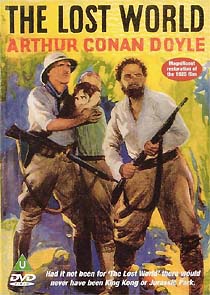 |
THE
LOST WORLD
Director:
Henry O. Hoyt
Starring:
Wallace Beery, Lewis Stone, Bessie Love
A group of explorers discover prehistoric creatures. This silent 1925 film, based on Sir Arthur Conan Doyle’s wonderful novel (recently dramatised again by the BBC), is a rollicking good yarn. The film benefits enormously from some pretty good stop-motion special effects, by the man who would go on to bring life to King Kong, Willis O’Brien. As is usually the case with surviving films from this era, The Lost World exists in several different versions, and, once again, the restoration process has been mildly controversial. Along with debates about which footage was actually intended to be used, and which Hoyt consigned to the cutting room floor, this version seriously undermines its aim as a restoration project by attempting to eliminate or tone down racial stereotypes. The tinted version on Eureka’s disc has been restored to something closely approaching its original length from eight different prints (most of them, understandably, heavily worn). The clarity and stability of the transfer is generally quite remarkable, and what might have been very smeary on VHS is rendered with much more precision on DVD. The disc offers a choice of three audio options: a traditional score (in 2.0 stereo, at 224kbps), a much more modern rock score and a commentary track by the author of The Annotated Lost World, Roy Pilot. The disc also contains a photo’ gallery, about twelve minutes of animation “outtakes”, and text articles on Conan Doyle, the film, and its restoration. It’s hard to fault Eureka’s presentation, from the striking and sturdy card slipcase, with its charming contemporary cover, to the disc’s unusually elaborate and atmospheric menus. This is an essential purchase for any serious film buff, or fan of the genre. |

